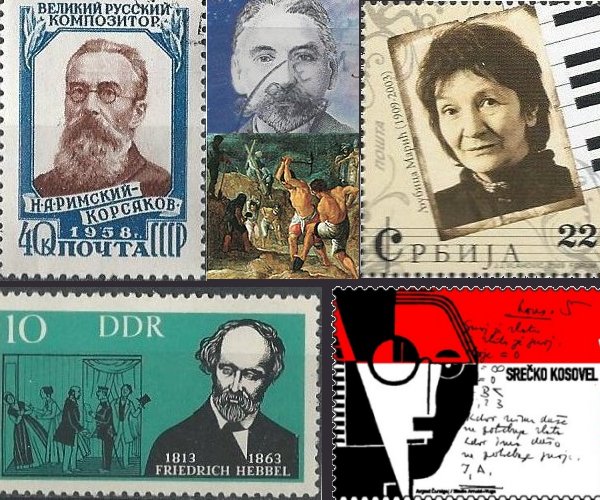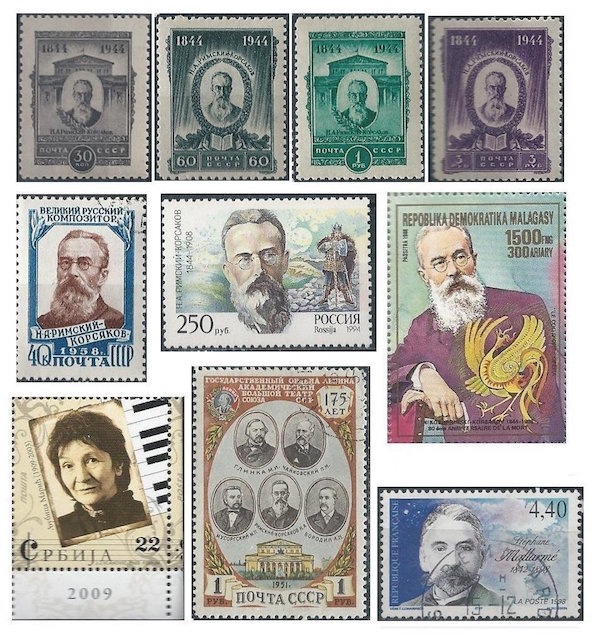The Arts on the Stamps of the World — March 18
An Arts Fuse regular feature: the arts on stamps of the world.

By Doug Briscoe
Nikolai Rimsky-Korsakov (18 March [O.S. 6 March] 1844 – 21 June [O.S. 8 June] 1908) followed his family, and in particular his beloved much elder brother Voin, into the Imperial Russian Navy, joining up at age 12. He didn’t actually go to sea until he was 19, when his orders took him to New York and Rio de Janeiro. This voyage interrupted work on his first symphony, though he did complete the slow movement during a stopover in England. He was still only 23 when named by the critic Stasov as one of “The Mighty Handful”. Even early on, Rimsky-Korsakov was particularly admired for his talent at orchestration. He was named Inspector of Naval Bands in 1873,a civilian post that allowed him to resign his naval commission. The position was abolished in 1884, but by that time Rimsky-Korsakov had already been teaching at the Saint Petersburg Conservatory for years. His students would include Glazunov, Liadov, Stravinsky, Prokofiev, and Respighi (who was in Saint Petersburg for several months in 1899). Besides his own compositions—15 operas, three symphonies, choral and chamber music, and many songs— Rimsky-Korsakov is famous for having orchestrated, reorchestrated, or competed works by his colleagues, most memorably Borodin’s Prince Igor and Mussorgsky’s Boris Godunov and Night on Bald Mountain. I find it interesting that his own three most popular orchestral works bear consecutive opus numbers: Capriccio Espagnol, Op. 34; Scheherazade, Op. 35; and the Russian Easter Overture, Op. 36. I’ve owned a copy of his autobiographical My Musical Life for years, but have never read it. Rimsky-Korsakov also wrote books on harmony and orchestration. All my Rimsky-Korsakov stamps are from Russia except the one issued by the Malagasy Republic in 1988. The Soviet stamp at bottom center honors the Bolshoi Theatre and depicts five composers, but not “The Mighty Five”. Rimsky-Korsakov is in the middle of this 1951 issue.
Today is also the birthday of Stéphane Mallarmé (18 March 1842 – 9 September 1898). By coincidence (I guess), both Maurice Ravel and Claude Debussy composed identically titled sets of Trois poèmes de Stéphane Mallarmé in the same year, 1913. They even used two of the same poems. The Ravel group uses an instrumentation modeled on that of Schoenberg’s Pierrot Lunaire, the Debussy is for voice and piano. Both composers had been inspired by Mallarmé’s poems much earlier: Ravel had set one, “Sainte,” in 1896, and Debussy’s Prelude to the Afternoon of a Faun (1894) was “a free interpretation” of Mallarmé’s poem “L’après-midi d’un faune” (1876). One of the most important works by the late Pierre Boulez, Pli selon pli, not only uses Mallarmé’s texts, but is even subtitled Portrait de Mallarmé. Some other composers who have sought inspiration from Mallarmé are Darius Milhaud, Louis Durey, Kaikhosru Sorabji, Ferenc Farkas, and Barbara Kolb. Two other purely instrumental works, besides Afternoon of a Faun, are a ballet—also styled a “Recitation orchestrale”—Hérodiade, by Hindemith (commissioned by Martha Graham, 1944) and American composer Robert Ward’s Serenade for Mallarmé for flute, violin, viola, and piano of 1991. The stamp was issued by France in 1998, the centenary year of Mallarmé’s death.
German artist Adam Elsheimer (18 March 1578 – 11 December 1610) was more significant than the relative obscurity of his name would suggest. His handling of light and his representations of night scenes influenced not only other artists of his day but also both Rembrandt and Rubens. Elsheimer was born in Frankfurt in a house that was still standing as recently as 1944, when Allied bombs destroyed it. He traveled to Munich and probably Venice (where his own models were Tintoretto and Veronese) on his way to Rome. There he met with other Northern artists, including Rubens (who scolded Elsheimer for not producing more work). Elsheimer remained in the Eternal City for the remainder of his life, from 1600 to 1610. Most of his forty or so paintings were executed on copper plate, his only self-portrait, which is on canvas, being an exception. I recall that a detail from one of his most important works, Tobias and the Angel (1602-03), was used as the cover illustration for Antal Doráti’s recording of Haydn’s seldom-heard oratorio Il ritorno di Tobia. Ironically the reason for the painting’s historical notability, its use of a broad landscape against which the foreground characters are set, a device that hadn’t been much seen since the early Renaissance, is lost in the cropping (perfectly reasonable in context) used for the album cover. The German stamp from 2007 shows us The Altar of the Cross (1603-05).

Elsheimer’s much later countryman, the poet and playwright Christian Friedrich Hebbel (1813 – 13 December 1863), was actually born a Danish subject into the family of a bricklayer in Holstein. As a teenager Hebbel sent some of his poems to the journalist Amalie Schoppe, who got him an entrée into the University of Hamburg. He studied further at Heidelberg and Munich. On finishing his studies he walked all the way back to Hamburg. His first tragedy, Judith (1840, made into an opera by Reznicek in 1922), established his reputation. (Another tragedy from 1840, Genoveva, was brought to the operatic stage by Schumann—his only opera—just ten years later.) Hebbel received a grant from the King of Denmark to visit Paris and Italy, with a stop at Vienna that turned permanent. To avoid a return to poverty so as to concentrate on his art, he gave up his love to marry a wealthy woman , an act he considered “the best of his life”! Besides Genoveva, Schumann also set Hebbel’s poetry in Lieder, as did Brahms, Liszt, Pfitzner, Berg, and many others.
We turn back to the visual arts for the Frenchwoman Marie Duhem, née Sergeant (1871 – 9 July 1918). She inherited her artistic inclinations from exposure to the designers and models her parents employed at their lace factory. She took to painting and met her husband Henri Duhem at the Wissant workshop of Adrien Demont and his wife Virginie Demont-Breton. The Duhems formed the “Wissant School” at their home in Camiers, painted neighboring areas, and began to collect art by such figures as Monet and Gauguin. The recent French stamp shows us her May Queen daisies in a vase (Reines marguerites dans un vase). She was devastated by the loss of her son in World War I and died three years later of a tumor, aged only forty-seven.

Slovene poet Srečko Kosovel (1904 – 26 May 1926) lived less than half as long, dying of meningitis at age 22, yet Wikipedia describes him as “one of central Europe’s major modernist poets”. An important voice in Slovenian culture and language, he strove to defend his heritage after the annexation by Italy of his Karst homeland following World War I. (His father was disallowed from continuing to teach school in Slovenian.) He grew up near the front and was witness to the common sight of corpses and ghastly wounds until his parents sent him and his sister to Ljubljana. After the war this city fell within the borders of the new Kingdom of Yugoslavia, which, in turn, showed little sympathy for the Slovenian minority. Kosovel thus became more frustrated and radicalized. With his prodigious energy he founded and/or edited at least three magazines and left 500 completed poems and a further 500 sketches. Though his poems exhibit the influences of several artistic movements, as a general rule his earlier work tends to Impressionism and his later pieces to Constructivism, with some boldly experimental writing.
We remain in the Balkans for Ljubica Marić (LYOO-bit-sa MAH-ritch; 18 March 1909 – 17 September 2003), apparently the first Serbian to earn a degree in composition (1929). She undertook postgraduate studies in Prague with the Czech composer Josef Suk and had her music championed by Hermann Scherchen. She is distinguished by her use of elements of Byzantine church music in secular compositions, notably a Byzantine Concerto for piano and orchestra of 1959. That work and three of her other orchestral pieces are available on a Chandos CD, which is a bit unusual in that Chandos tends not to reissue older recordings, and these are all taken from recording sessions of 1964 and 1977. The stamp comes from a 2009 sheet honoring eight Serbian composers.
I’m quite sure there will one day be a stamp for John Updike (March 18, 1932 – January 27, 2009), but that day has not yet arrived.
A graduate of the University of Massachusetts with a B.A. in English, Doug Briscoe worked in Boston classical music radio, at WCRB, WGBH, and WBUR, for about 25 years, beginning in 1977. He has the curious distinction of having succeeded Robert J. Lurtsema twice, first as host of WGBH’s weekday morning classical music program in 1993, then as host of the weekend program when Robert J.’s health failed in 2000. Doug also wrote liner notes for several of the late Gunther Schuller’s GM Recordings releases as well as program notes for the Boston Classical Orchestra. For the past few years he’s been posting a Facebook “blog” of classical music on stamps of the world, which has now been expanded to encompass all the arts for The Arts Fuse.
